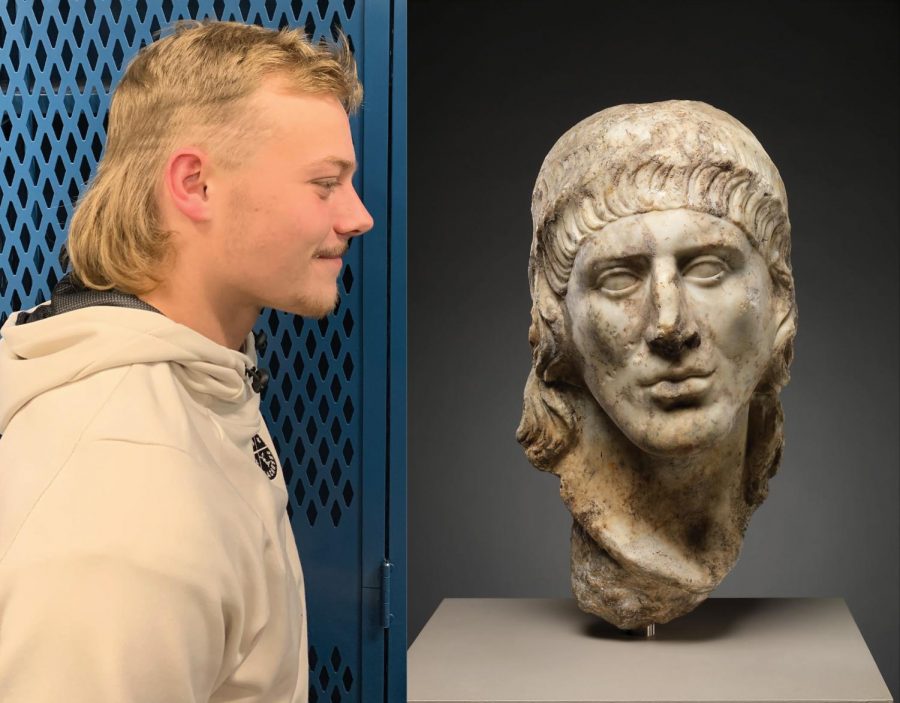The Mullet: Who Do You ‘Doo?
Matt Nault/"Marble Head of Man" with permission from metmuseum.org via Creative Commons
Left: Senior Brennan Morrissey can be seen rockin’ a mullet in his daily life. Morrissey is carrying on the fabulous hairstyle all throughout Superior high school. Right: Roman sculpture resting in New York’s Metropolitan Museum from the early 2nd Century A.D., depicting an ancient Roman who’s cut his hair in what might be the world’s first mullet, most likely dedicated to the chariot-riding celebrities of the time who sported the same cut. When in Rome, do as the Romans ‘doo.
November 18, 2019
Ape Drape, Norce Neck Warmer, Hockey Hair, Achy Breaky Hair, Mullet, Forbidden Hair, Shom. All these names labelize an iconic hairstyle known for its short frontal-length and long, untamed back-mane, and as immortalized in the 1998 punk song ‘Ape Drape’ by The Vandals, “The front may conform to society, but the back says I have personality, even if it’s really, really, really, really bad.”
The style is something of an anathema to at least three generations, and we have the Beastie Boys to thank for bringing the abhorred word ‘mullet’ into our language. It’s been the bane of every self-respecting hairstylist; though, it can be dated back to the sixth century when Byzantine scholar Procopius wrote of the cliques of young men who wore their hair long in the back, and short in the front. It was deemed the ‘Hunnic’ look, and was hated even as far as 2,619 years ago because it was non-Roman! Suppose today we call it non-conformist.
The 1980’s saw the height of this hairstyle’s popularity in continental Europe, known by many different terms depending on the country it was worn in, and the 80’s also saw the cut connected with lesbian culture, as those who identified themselves as a part of the community would cut their hair into a mullet and look for others out in public who sported their hair. This trend carried on throughout the years, and the Indie duo Tegan and Sara wore mullets during their The Con album era, making it a famed look once more in the LGBT community.
So why did it go out of style? What drove vocalist Wesley Willis to write the song Cut The Mullet? I’ve long sought an answer for this, ever since I was a young kid watching Tegan and Sara music videos and coveting the hairstyle-that-should-not-be-named, and the conclusion became clear to me the night I saw a low-resolution image of Julian Casablancas of The Strokes-fame and his greasy mullet on my Twitter feed four years ago. It’s all the last generation’s fault!
Indeed, who else but the last generation, our parents, would have such a grudge toward this style that they propagate their biases onto the younger generation until the mullet became a stigma. Whether it was because it reminds them of their high-school bully, a bad phase they had, the painful memory of their dads giving them matching mullets one day after school, or just because it’s something cool they had that they don’t want their kids to have, like affordable housing or rock ‘n roll, the adults have successfully warped the image of a mullet into an ugly thing that only belongs on a Soft-Cell album cover. And of course they ignore the early 2000’s ‘Electro-Mullet’ style popular among underground punk and indie scenes, which retained mullet qualities, but in a way that was way cooler than anything they could conjure up.
But it’s not all in the past. In this decade, Iran has banned the mullet for it’s being a ‘decedant Western symbol’ (can’t be totally dead if it’s getting that kind of pushback), various famous Kpop Idols have worn the cut and made it popular amongst fans and other Korean-pop artists alike, and American sports players and coaches have made millions off merchandising their mullets.
As time passes the mullet grows in popularity, and soon, when it’s accepted by the masses and the smoke clears, we’ll look back on our anti-mullet detestation as a simple bad-trend brought to us by balding adults who miss that clean but rebellious set of hair. Hopefully. (Please don’t mess it up).











